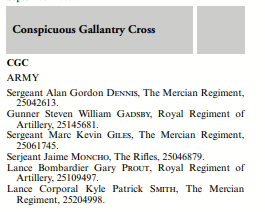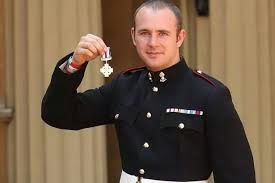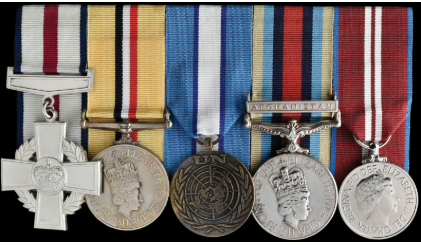b. 28/01/1985 Louth, Lincolnshire.
DATE OF CGC ACTION: 09/05/2009 near Check Point Haji Alem, Helmand Province, Afghanistan.
Lance-Bombardier Steven Gadsby was born on 28 January 1985 in Louth, Lincolnshire, and joined the Royal Artillery in 2002. As part of the 40th Regiment (The Lowland Gunners) Royal Artillery, he served during the Iraq War of 2003-11, seeing active service in 2003 as part of his Brigade Search Team. During this time he was regularly sent out to perform house-to-house searches of locations which British Intelligence had suggested were likely locations of explosives, guns and cash, largely in Basra and at the nearby Al-Zubair Port. He spent a period of time serving in Cyprus in 2004, providing support along the ‘Green Zone’ of the divided city of Nicosia, and at barracks in Northern Ireland, before returning for a second tour in Iraq in 2006-7.
During this second tour he undertook similar Search Team work, in addition to regular close protection and escort duties (including several minor incidents of hostile fire) and work in local prisons. In his own words, Gadsby was ‘not always the best-behaved soldier’, but he made up for it by being ‘bloody good at the job’. A tough, loyal, and popular character, he had been a brigade-level heavyweight boxer and ‘was not a man to mess with’ (as recorded in ‘Dead Men Risen: The Welsh Guards and the Defining Story of Britain’s War in Afghanistan’ by Toby Harnden). Despite his obvious ability as a soldier and fighting man, his career progression had been held back by repeated disciplinary issues. As he later reflected ‘I’ve been a bad lad for most of my time and pretty much ruined my own career…I’ve gone A.W.O.L. a few times – not for long – disobeying orders, just things like that. I’ve been arrested for fighting… and then got let off the hook because the bloke dropped the charges. You get arrested fighting in town and then in the morning an ex-squaddie who’s on duty just gives you a fine and says: “Don’t do it again.”’ (Dead Men Risen, page 170). Nonetheless, it was in 2009, after 7 years in the Army and still as a Gunner, that he was sent to serve as Fire Support Team Signaller, on attachment with the 1st Battalion, Welsh Guards, in Afghanistan.
The 1st Battalion, Welsh Guards were sent to serve in Helmand Province, Afghanistan in April 2009, and Gadsby would join 7 Platoon, part of the Number 2 Company Group, operating in the south of Nadi-e-Ali. 7 Platoon, under its talented Platoon Commander Lieutenant Mark Evison (nicknamed ‘007’ or ‘The Boss’), made its temporary home at Haji-Alem, a stout four-sided fort with metre-thick walls of 50 metres each in length and with a General Purpose Machine Gun (G.P.M.G.) tower on each corner. Despite the extremely basic facilities, and the general ‘lack of radios, water, food and medical equipment’ (as Evison’s diary, poignantly recorded) they maintained an excellent level of morale and formed a very tight-knit unit of tough fighting men. Lieutenant Evison, however, rued the overall lack of manpower and medical equipment at his disposal very early on, recording in his journal: ‘It is disgraceful to send a platoon into a very dangerous area with two weeks’ water and food and one team medic’s pack. Injuries will be sustained that I cannot treat, and deaths could occur which could have been stopped…we are walking a tightrope…’ Lacking a clearly defined mission beyond ‘bringing stability to the area’, 7 Platoon undertook regular patrols in the fields and sangars surrounding their compound, despite it being under clear Taliban control.
Following the actions of Gadsby in evacuating the wounded men, at 9.47am a Black Hawk helicopter made a ‘hot’ landing in their compound under enemy fire, and took off again with Evison onboard for Camp Bastion in less than one minute. Arriving at Camp Bastion in 14 minutes, he was then in the theatre within an hour and 23 minutes of being shot. Despite the heroics performed by Gunner Gadsby, Guardsman Korosaya and the men of 7 Platoon, his evacuation still fell outside the so-called ‘golden hour’ for emergency treatment, and even after undergoing initial emergency surgery at Camp Bastion, Evison’s situation remained dire. He was swiftly evacuated back to Britain, by which time it was clear that his brain had suffered from such dramatic blood loss at the time of the incident, and the decision was taken by his family to turn off his life-support at the Selly Oaks Hospital in Birmingham on 12 May 2009.
7 Platoon remained in Afghanistan until late 2009, and the fort at Haji-Alem was then bombed by NATO forces to prevent it falling into the hands of the Taliban. Elsewhere, 1st Battalion, Welsh Guards also took part in Operation Panther’s Claw on 25 June 2009 fighting along the Shamalan Canal near the epicentre of the fighting at Babaji, helping to restrict Taliban access to the area. Later, Gadsby returned for a second tour in 2011-12 as part of Operation Herrick 15, however this service, although still clearly challenging – especially in light of his previous tour – was apparently rather more routine.
Gunner Gadsby was recommended for the Conspicuous Gallantry Cross, Britain’s second highest decoration for combat gallantry after the Victoria Cross, by the Commanding Officer of the 1st Battalion, Welsh Guards, on 20 September 2009, with the award being formally announced in The London Gazette of 19 March 2010. Gadsby was invested with the C.G.C. by Her Majesty The Queen at Buckingham Palace on 2 June 2010, who spent a minute or two speaking with him, making the comment that she ‘was proud of him for what he had done for his country’ as she pinned the decoration to his chest, while also delicately noting the sad loss of Lieutenant Evison, showing her personal and meticulous knowledge of the armed forces. Gadsby soon afterwards took the decision to place the medal and group on loan for several years at ‘Firepower – The Royal Artillery Museum’, formerly of Woolwich, London. After the Museum was closed in 2016, the medal was subsequently stored at R.H.Q. Royal Artillery, Larkhill Garrison, Wiltshire, until it was formally returned to the recipient at his own specific request in July 2021.
CGC CITATION:
Gunner Gadsby has been serving as a signaller with a Fire Support Team based in Check Point Haji Alem in the Nadi-e-Ali area. On the 9 May 09, Gunner Gadsby deployed from the base as part of a routine foot patrol. Around 500 metres into the patrol, insurgents contacted them with small arms fire. Two enemy firing points quickly became four. The Platoon found itself separated on either side of a piece of open ground. Worse was to follow when the Platoon Commander was hit and mortally wounded. Insurgents continued to flood the area, outflanking the ground callsign to fire from a fifth and then a sixth compound, before finally encircling them. The patrol fought back bravely and regrouped in a rally point from which they prepared to return to base. Gadsby was tasked to help with the extraction of the injured Platoon Commander. The going was extremely difficult due to the wide open fields – the only available cover was chest-high water-filled irrigation ditches. A tremendously strong man, Gadsby manned the stretcher the whole way back. The going was incredibly hard as they forced their way along the irrigation ditch, under fire throughout. 100 metres from the check point a significant hurdle awaited them in the form of an exposed track-canal-track obstacle and a piece of open ground leading up to the gate. This ground was in full view of the insurgents who were continuing to harass the patrol and were now firing liberally at this open ground. By now it was clear that the condition of the injured Platoon Commander was deteriorating rapidly – he urgently needed stability and proper medical care. To dip down into the cover of the canal which ran across the open ground would have provided cover from view and fire, but it would have taken more time.’ ‘Without a word, acting entirely on his own initiative, and with complete disregard for his own safety, Gadsby threw the Platoon Commander over his shoulder and sprinted across the Infantry Foot Bridge that ran over the canal and back into the base. Rounds zipped in front of his face and around his feet as he ran. Once in the check point he laid the Platoon Commander down by the Patrol Medic and collapsed on the ground with exhaustion. An Afghan soldier then indicated with sign language that another soldier had been injured in the canal. Having just run through a storm of bullets Gadsby was fully aware of the consequences of going back out through the gate. Again, on his own initiative and without a thought for his own safety, Gadsby put his body armour and helmet back on and he ran straight back out. Immediately the insurgents began directing a heavy weight of fire at him. Finding Guardsman Gizzie immobilised on the canal bank with gun shot wounds to both ankles, Gadsby threw Gizzie over his shoulder and ran back inside across fifty metres of exposed ground. Again bullets flew all around him but miraculously he made it back to the base unscathed. Again he handed over his charge to the medic and he collapsed with exhaustion.’ ‘Gadsby’s actions displayed a complete disregard for his safety on two occasions to try to save the lives of others. His decision to run across the Infantry Foot Bridge in view of the enemy rather than to cross the canal in cover gave the two casualties the very best chance of survival by getting them to medical aid as quickly as possible. That he then risked his life a second time, knowing the dangers that awaited him outside the Check Point is supremely worth of official recognition.’
LOCATION OF MEDAL: PRIVATELY HELD. SOLD AT MORTON & EDEN FOR f100,000 ON 29/11/2021.



